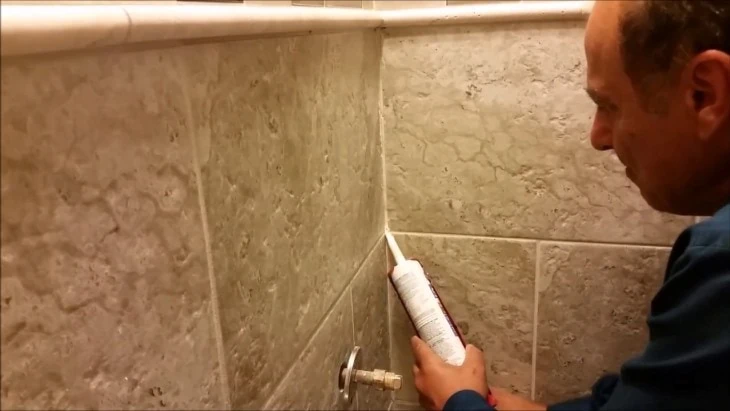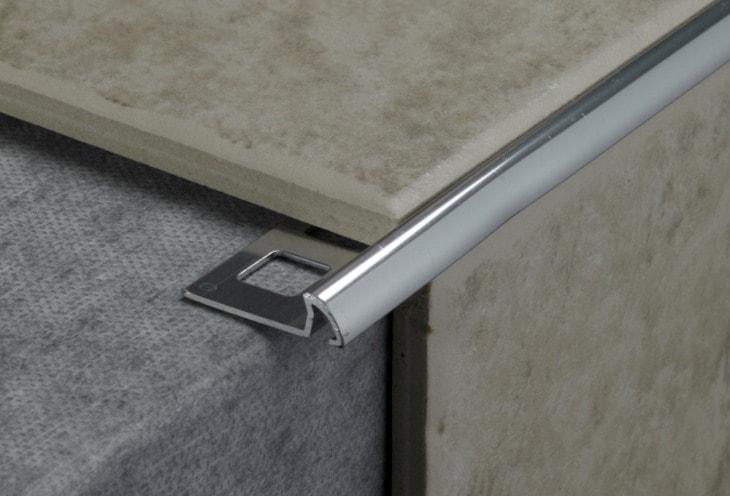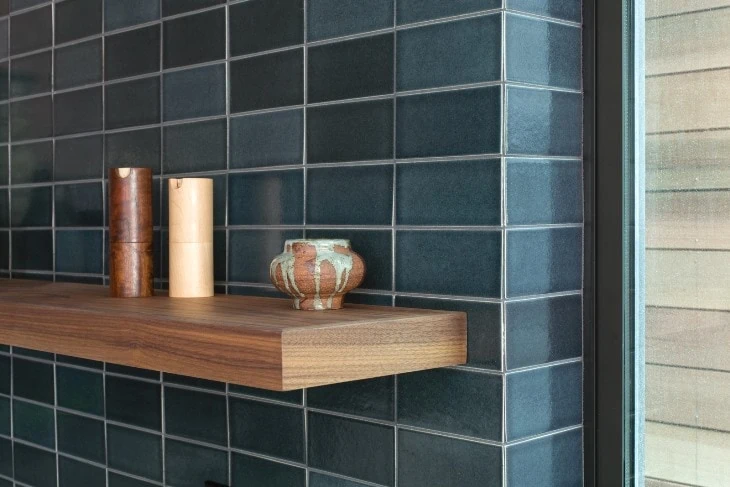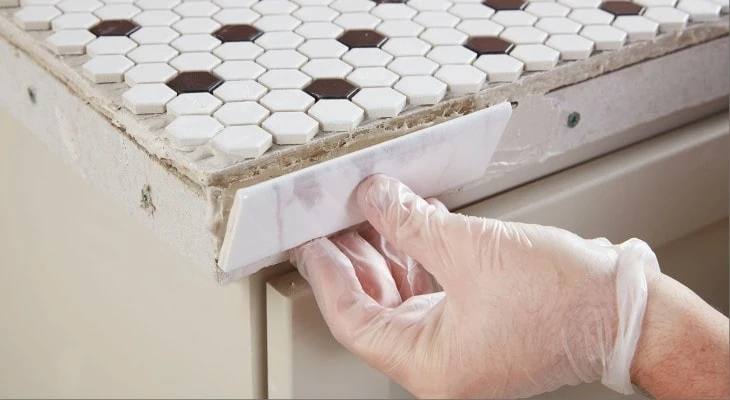After installing new tiles for your home improvement project, it’s important that the edges have a clean, crisp look. Exposed tile edges can not only look unsightly, but they can cause injury if somebody steps on them or runs their hand along the edge.
You have a few options when hiding exposed tile edges or making them look finished. You can use caulk, plastic or metal molding, and even custom bullnose trim. Hiding the exposed edges will not only avoid accidental injuries but also help preserve the life of your tile by preventing any wear and cracks.
Get in touch with a designer or a contractor to determine which option best fits your needs when it comes to hiding exposed tile edges.
Table of Contents
Using Caulk to Hide Edges

This method is the most cost-effective and it’s also the easiest, making it a simple project you can take on yourself.
Shop for the Right Color
Your local hardware store should sell caulk that matches the color of your existing grout. This ensures a seamless look while also providing a water-tight finish to prevent damage to the tile.
I’ve personally used this Gorilla White 100% Silicone Sealant Caulk quite a few times and found it quite good.
Applying the Caulk
Make sure the area is dry before applying the caulk. In one smooth motion, apply the caulk to the exposed edges making sure to go all the way to the corner. Next, take a damp cloth around your fingertip and run it along the fresh caulk while it’s still wet.
The goal is to have one even caulk line application. Apply any extra caulk needed as soon as possible. If the caulk gets on any painted walls, you can use a small amount of paint to touch it up.
Using Metal or Plastic Molding
Metal and plastic trim pieces can give your tile a contemporary look. The downside is that these pieces can be pricier.
Choosing the Right Metal Trim

The most popular type of metal trim is called Schluter Jolly. They can be used in both wall applications, such as bathrooms, as well as floor applications.
The bonded portion of the metal trim sits below the tile, so this can be tricky to install after the fact, but it’s still possible with the right expertise.
Another important thing to keep in mind is that metal edge pieces come in all kinds of shapes and finishes. The general rule of thumb is to try to get the finish of the metal trim to match the finish of the existing (or to be installed) fixtures.
Consult with an expert in choosing the size, or depth, of your trim piece. The industry standard is 1/16” or 1/8”.
Choosing the Right Plastic Trim
Choosing plastic trim over metal can save you money, but be aware that this option is more prone to abrasions and general wear and tear. On the plus side, it’s flexible and easy to cut to size without specialized tools.
Just like with most home improvement projects, take special care in choosing the right size and color of your plastic trim. There are a plethora of options available to match or compliment your desired finished look.
Using Bullnose Edging to Hide Edges
Bullnose trim is known for its distinctive rounded edges making this a great choice of tile finish for corners. It is also extremely versatile so it can be used in almost any area that has tile, even floors.
It has been used in tile finishing for houses since the 1920s and 30s, so it has a very classic feel to it that can’t be beaten!
Bullnose edging can round out sharper corners and features, giving a smoother finish to walls and window niches. It can even be used in place of baseboards which can be beneficial for the overall appearance of bathroom floors.
Finding the Right Bullnose for Your Project
It’s important to pre-plan before buying any bullnose that you may need. Some tile finishing can be purchased with matching bullnose pieces so that everything is a uniform color. If you are unable to find one that matches your preferences, you have the option of getting them custom-made.
There are also different types of bullnose. Standard bullnose edging will have one rounded edge to fit snugly around corners & blend the tile pieces together.
There may be a need for two rounded edges, such as the very end piece of a backsplash, in which case a corner bullnose would be a suitable option.
Sometimes, three edges come to a point and you will need to buy a specific piece for a prominent corner called a beak or a corner cap.
Some Things to Consider for Your Project
With most renovations, pre-planning is an important part of the process before beginning any project. Keep in mind some of these important points when determining which trim option will work best for you.
Which Room Are You Renovating?
Bathrooms will usually have a different look and feel than kitchens. Most commonly, ceramic and stone bullnose edging is used in kitchens while metal, plastic, and caulk options are seen more in bathrooms.
Kitchen backsplashes specifically look cleaner and more cohesive with a ceramic bullnose tile edge.
What is Your Desired Aesthetic?

For modern styles, clean and crisp edges are usually desired. Consider caulk, metal, and plastic trim options to achieve this look. You also have the ability to match finishes to current fixtures to tie the whole room together.
If you are going for a more classic look, bullnose edges could be the trim of choice. They help create a seamless design and reduce sharp edging contrasts.
What is Your Budget?
Shop around for different prices of varying edge pieces. Caulk is certainly the most budget-friendly finishing product, but plastic trim is also an affordable option. Metal and bullnose edging may add more to the overall project price, but the end result can be worth it!
Final Thoughts
Explore all the possibilities for hiding your exposed tile edges and keep in mind the style of your house as well as the overall budget. Thankfully, there are multiple different options to help you get the finished look you desire.

